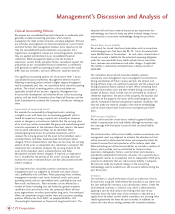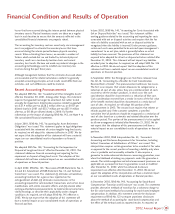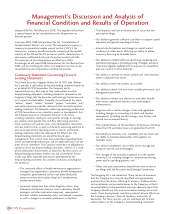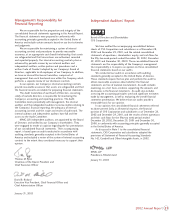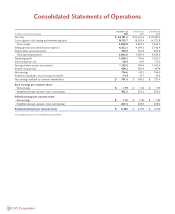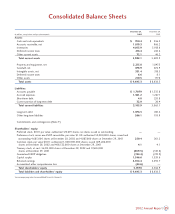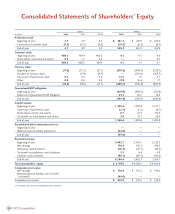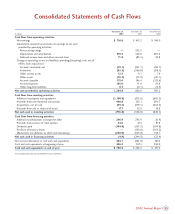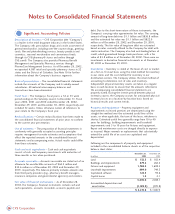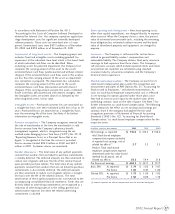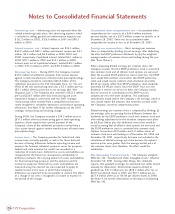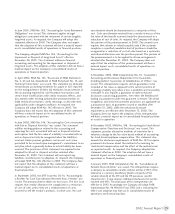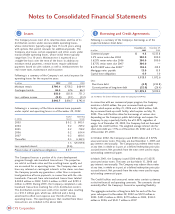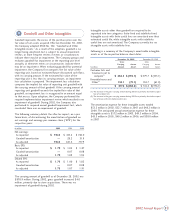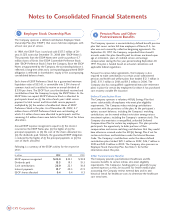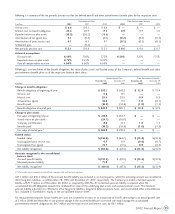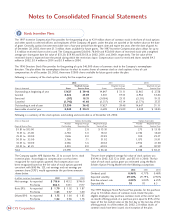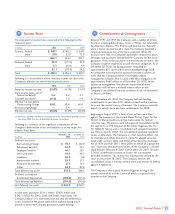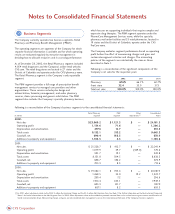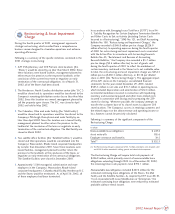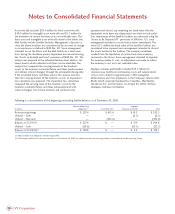CVS 2002 Annual Report Download - page 30
Download and view the complete annual report
Please find page 30 of the 2002 CVS annual report below. You can navigate through the pages in the report by either clicking on the pages listed below, or by using the keyword search tool below to find specific information within the annual report.
Advertising costs ~Advertising costs are expensed when the
related advertising takes place. Net advertising expense, which
is included in selling, general and administrative expenses was
$152.2 million in 2002, $126.9 million in 2001 and $90.5
million in 2000.
Interest expense, net ~Interest expense was $54.5 million,
$65.2 million and $84.1 million and interest income was $4.1
million, $4.2 million and $4.8 million in 2002, 2001 and
2000, respectively. Capitalized interest totaled $6.1 million in
2002, $10.1 million in 2001 and $14.1 million in 2000.
Interest paid, net of capitalized interest, totaled $60.7 million
in 2002, $75.2 million in 2001, and $98.3 million in 2000.
Nonrecurring items ~During 2001, the Company received
$50.3 million of settlement proceeds from various lawsuits
against certain manufacturers of brand name prescription drugs.
The Company elected to contribute $46.8 million of the
settlement proceeds to the CVS Charitable Trust, Inc. The net
effect of the two nonrecurring items was a $3.5 million pre-tax
($2.1 million after-tax) increase in net earnings (the “Net
Litigation Gain”). The Company also recorded a $352.5 million
pre-tax ($230.5 million after-tax) restructuring and asset
impairment charge in connection with the 2001 strategic
restructuring, which resulted from a comprehensive business
review designed to streamline operations and enhance operating
efficiencies. See Note 11 for further information on the 2001
strategic restructuring and resulting charge.
During 2000, the Company recorded a $19.2 million pre-tax
($11.5 million after-tax) nonrecurring gain in total operating
expenses, which represented a partial payment of the
Company’s share of the settlement proceeds received from a
class action lawsuit against certain manufacturers of brand name
prescription drugs.
Income taxes ~The Company provides for federal and state
income taxes currently payable, as well as for those deferred
because of timing differences between reporting income and
expenses for financial statement purposes versus tax purposes.
Federal and state incentive tax credits are recorded as a
reduction of income taxes. Deferred tax assets and liabilities are
recognized for the future tax consequences attributable to
differences between the carrying amount of assets and liabilities
for financial reporting purposes and the amounts used for
income tax purposes. Deferred tax assets and liabilities are
measured using the enacted tax rates expected to apply to
taxable income in the years in which those temporary
differences are expected to be recoverable or settled. The effect
of a change in tax rates is recognized as income or expense in
the period of the change.
Accumulated other comprehensive loss ~Accumulated other
comprehensive loss consists of a $44.6 million minimum
pension liability, net of a $27.3 million income tax benefit, as of
December 28, 2002. There was no accumulated other
comprehensive income or loss as of December 29, 2001.
Earnings per common share ~Basic earnings per common
share is computed by dividing: (i) net earnings, after deducting
the after-tax ESOP preference dividends, by (ii) the weighted
average number of common shares outstanding during the year
(the “Basic Shares”).
When computing diluted earnings per common share, the
Company assumes that the ESOP preference stock is converted
into common stock and all dilutive stock options are exercised.
After the assumed ESOP preference stock conversion, the ESOP
trust would hold common stock rather than ESOP preference
stock and would receive common stock dividends (currently
$0.23 per share) rather than ESOP preference stock dividends
(currently $3.90 per share). Since the ESOP Trust uses the
dividends it receives to service its debt, the Company would
have to increase its contribution to the ESOP trust to
compensate it for the lower dividends. This additional
contribution would reduce the Company’s net earnings, which in
turn, would reduce the amounts that would be accrued under
the Company’s incentive compensation plans.
Diluted earnings per common share is computed by dividing: (i)
net earnings, after accounting for the difference between the
dividends on the ESOP preference stock and common stock and
after making adjustments for the incentive compensation plans
by (ii) Basic Shares plus the additional shares that would be
issued assuming that all dilutive stock options are exercised and
the ESOP preference stock is converted into common stock.
Options to purchase 20.0 million and 5.2 million shares of
common stock were outstanding as of December 28, 2002 and
December 29, 2001, respectively, but were not included in the
calculation of diluted earnings per share because the options’
exercise prices were greater than the average market price of
the common shares and, therefore, the effect would be
antidilutive.
New Accounting Pronouncements ~The Company adopted,
SFAS No. 142, "Goodwill and Other Intangible Assets" effective
December 30, 2001. Among other things, this statement
requires that goodwill no longer be amortized, but rather tested
annually for impairment. Amortization expense related to
goodwill was $31.4 million pre-tax ($28.2 million after tax, or
$0.07 per diluted share) in 2001 and $33.7 million pre-tax
($31.9 million after-tax, or $0.08 per diluted share) in 2000.
See Note 4, for further information on the impact of adopting
SFAS No. 142.
Notes to Consolidated Financial Statements
28 CVS Corporation


